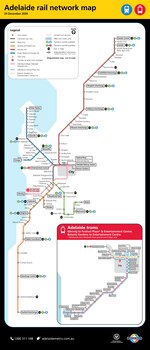Our website is made possible by displaying online advertisements to our visitors.
Please consider supporting us by disabling your ad blocker.
Adelaide Metro
 | |
 | |
| Parent | Government of South Australia |
|---|---|
| Founded | 23 April 2000 |
| Headquarters | Adelaide |
| Service area | Adelaide |
| Service type | Bus (Includes O-Bahn), Tram & Train |
| Operator | Torrens Transit Busways Keolis Downer (SouthLink) |
| Website | adelaidemetro.com.au |
Adelaide Metro is the public transport system of the Adelaide area, around the capital city of South Australia. It is an intermodal system offering an integrated network of bus, tram, and train services throughout the metropolitan area. The network has an annual patronage of 79.9 million, of which 51 million journeys are by bus, 15.6 million by train, and 9.4 million by tram.[1] The system has evolved heavily over the past fifteen years, and patronage increased dramatically during the 2014–15 period, a 5.5 percent increase on the 2013 figures due to electrification of frequented lines.[2][3]
Adelaide Metro began in 2000 with the privatisation of existing government-operated bus routes. Services are now run by two private operators[dubious – discuss] and united with common ticketing systems, marketing, liveries and signage under the supervision of the state government's Department for Infrastructure and Transport. Since the 2010s, energy sustainability and eco-friendly transport has been a major focus for Adelaide Metro. Hence, the fleet has been progressively upgraded with electric trains and solar-powered buses–one of which, known as the Tindo electric bus, is 100% solar powered and the first of its kind in the world.[4][5] Despite this, as of 2016, almost 80 percent of Adelaide's metropolitan buses still run on diesel fuel rather than biodiesel or batteries.[6]
Currently, the Adelaide Metro encompasses seven different train lines, the sole Glenelg tram line, which is the only one of Adelaide's tramways to survive the 1950s and the only one to be integrated into the current system, with extensions added in the 2010s, and over 300 bus routes. [7]
- ^ South Australia Department of Planning, Transport and Infrastructure (September 2019). "Annual Report 2018–19" (PDF). Archived (PDF) from the original on 1 March 2020. Retrieved 12 February 2020.
- ^ "Record Adelaide Metro patronage as passengers flock to train network". Premier of South Australia. 23 July 2015. Archived from the original on 24 September 2015. Retrieved 10 August 2015.
- ^ "Annual Report 2009–2010" (PDF). TransAdelaide. Archived from the original (PDF) on 27 February 2012. Retrieved 4 March 2012.
- ^ "New electric train chosen for Adelaide". The Advertiser. 10 November 2010. Archived from the original on 21 May 2013. Retrieved 17 July 2015.
- ^ "Adelaide Creates World's First Solar-Powered Public Transit System". Ecolocalizer. 11 September 2013. Archived from the original on 22 July 2015. Retrieved 18 July 2015.
- ^ "Almost 80 per cent of Adelaide metropolitan buses run on regular diesel". The Advertiser. 17 April 2016. Retrieved 17 April 2016.
- ^ "Timetables". Adelaide Metro. 30 October 2024.
Previous Page Next Page





